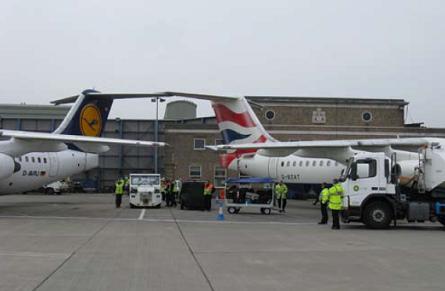Failure by ground personnel to monitor tail clearance while manoeuvring, ironically, to ensure wingtip avoidance led to the minor collision between two BAE Systems Avro RJs at London City a year ago.
The Lufthansa RJ85, parked on stand, had attempted to taxi forwards and turn right but stopped after a ground marshaller signalled that its left wingtip would not clear the right wingtip of an adjacent parked British Airways CityFlyer RJ100.
To provide wing clearance a tug pushed the RJ85 backwards by a short distance. The jet then attempted again to taxi forward and to the right. While the wingtips cleared one another, the RJ85's horizontal stabiliser passed under and scored the right stabiliser of the RJ100.
"The net effect of [the pushback] was to increase the wingtip clearance, while reducing the tail clearance between the two aircraft, which went unnoticed," says the UK Air Accidents Investigation Branch.
 |
|---|
© Air Accidents Investigation Branch |
Civil Aviation Authority guidance advises minimum clearance of 20% for manoeuvring, but the tight parking at London City means this is not always practical. Although London City's operator required ground personnel to monitor wingtip clearance, the AAIB says the possibility of tail contact "had not been identified".
Since the incident, on 21 April last year, London City has introduced specific procedures to provide tail clearance monitoring by ground marshallers.
Damage to the aircraft was minimised by the RJ85s' passengers being kept seated, to prevent the jet rising up on its landing-gear assemblies, until ballast could be brought on board.
Source: Air Transport Intelligence news
















